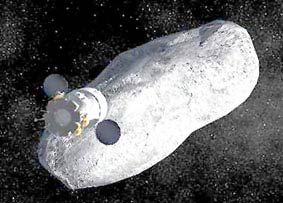Will NASA take people to meteors?
The US National Aeronautics Agency (NASA) is pursuing the Constellation Program , which will deploy Orion spacecraft to replace the space shuttle, first making flights to the International Space Station ( ISS), then take people and goods to the Moon. Next it will be the mission to expedite Mars and planets further. However, this program is not as noticeable by the project of bringing the crew to the meteorite or near-Earth object (NEO) which is causing a lot of controversy in the space of space science .
Space technology experts have suggested this idea that the mission to bring people to meteorites, once successful, will bring a lot of benefits and can set the stage for travel to the Moon and Mars. and distant galaxies. However, with many people, the NEO is the danger waiting for the immediate, capable of bumping into the Earth, so what to do is learn these ' mobile monsters ' as soon as possible.
Under NASA's scheme, 2 or 3 astronauts will fly to NEO on a 90-120 day journey, in which they will stay there for 1 or 2 weeks. According to Harrison Schmitt, a former astronaut who joined the Apollo 17 spacecraft and is currently chairman of the NASA Advisory Council, the mission to bring people to NEO is a viable idea, and will be an opportunity to test their features. system in the constellation program as well as to " overcome technical gaps " before reaching Mars.

Airship cruise simulation approaching NEO.(Photo: Space.com)
So far, according to sources from Lockheed Martin Space Systems, the Orion spacecraft manufacturer, NASA has not mentioned the improvement of the Orion vessel to take on the mission of bringing people to NEO. But, for the past two years, Lockheed Martin has been extending its own technology to ensure Orion is able to reach destinations other than ISS.
An expert of Lockheed Martin said that from an architectural perspective, the idea of making a round-trip flight to meteorites is not difficult, but technically it requires the engine of the spacecraft to have very strong propulsion, along with with a large cabin space required for the crew, as well as oxygen and water supply systems . In addition, the journey from Earth to NEO and back to Earth is an ' open ' type trip, with far more distance than to the Moon, the risk will be more. So, one of the essential things is the psychological "tutoring" for astronauts.
Recently, DigitalSpace company in Santa Cruz, California has announced a simulated journey that brings people to NEO, according to Druce Damer, founder of DigitalSpace, ' very useful for NASA's pre-feasibility study project. will be completed this year '.
According to Clark Chapman, planetary scientist at Southwest Institute in Colorado, the NEO study will provide both scientific and practical concepts, for many reasons such as NEO made up of common materials and Unlike the material present near the Earth's surface, NEO has negligible gravity . So NEO is the 'raw material' source for human space exploration in the future.
Also interested in NEO, now experts of Ball Aerospace & Technologies are researching to design NEO discovery equipment from outside to inside. The device is as small as a basketball, weighs several hundred grams, and once released it will fall freely into the surface of the NEO and begin transmitting the collected results to the spacecraft. It is rated to be within NASA's sights.
Ninh
- NASA asked people to hunt for killer meteors
- NASA continues to hunt for dangerous meteors
- NASA lacks money to track meteors
- NASA's meteorite hunt mission failed
- Video: Huge meteorite glides through the American sky
- Giant meteors are about to destroy the Earth
- Apocalyptic Earth in early March: What conclusion does NASA make?
- NASA considered using nuclear weapons against the apocalypse
- Rare footage: A piece of meteorite hits the ground, illuminating a sky
- Things you don't know about meteors
- The American spacecraft will crash into the meteorite
- NASA completed the ship to hunt for meteors
 Van Allen's belt and evidence that the Apollo 11 mission to the Moon was myth
Van Allen's belt and evidence that the Apollo 11 mission to the Moon was myth The levels of civilization in the universe (Kardashev scale)
The levels of civilization in the universe (Kardashev scale) Today Mars, the sun and the Earth are aligned
Today Mars, the sun and the Earth are aligned The Amazon owner announced a secret plan to build a space base for thousands of people
The Amazon owner announced a secret plan to build a space base for thousands of people